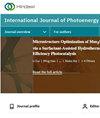Fabrication and Performance Evaluation of Solar Tunnel Dryer for Ginger Drying
IF 2.1
4区 工程技术
Q3 CHEMISTRY, PHYSICAL
引用次数: 7
Abstract
A series of tests were conducted to investigate the performance of a solar tunnel dryer for drying ginger. To supply hot air to the dryer, two axial flow fans with a power rating of 28 W, a supply voltage of 220 V, and a 50 W photovoltaics (PV) module were employed. By dividing the 8.5-meter-long solar tunnel dryer into four equal portions every thirty minutes, solar radiation, dry air temperature, ambient temperature, relative humidity, and air velocity were measured at five solar tunnel dryer stations. The hot air temperature at the collector output grew from 34°C to 65.5°C for an 8-hour operation in the no-load condition when the solar radiation was changed between 540 and 820 W/m2. At 9:00 a.m., the average maximum temperature was 30°C. During the loading operation, the temperature was 77°C at 1:00 p.m. The moisture content of sliced ginger was reduced from 90.4 to 11.8% on a wet basis using the solar tunnel dryer. With a solar collector area of 6 m2, open sun drying takes 40 hours to achieve the same wet basis condition. A total of eight experiments were carried out, both with and without loads. The dry air temperature at the collector outlet ranged from 34.0 to 65.5 °C. As the drying efficiency, collector area, and time savings improve, the drying time decreases. The ginger is kept in a controlled area, resulting in high-quality dried ginger. The solar tunnel dryer showed a net saving in drying time of 40% over open sun drying.太阳能隧道式生姜干燥机的研制及性能评价
通过一系列试验研究了太阳能隧道式干衣机干燥生姜的性能。为向干燥器提供热空气,两个额定功率为28的轴流风扇 W、 220的电源电压 V、 和一个50 采用W光伏(PV)模块。通过每30分钟将8.5米长的太阳能隧道干燥器分成四等分,在五个太阳能隧道干燥器站测量了太阳辐射、干燥空气温度、环境温度、相对湿度和空气速度。当太阳辐射在540和820之间变化时,在空载条件下运行8小时,收集器输出端的热空气温度从34°C上升到65.5°C W/m2。上午9时,平均最高温度为30°C。在装载操作过程中,下午1点的温度为77°C。使用太阳能隧道干燥器,生姜片的水分从90.4%降低到11.8%。太阳能收集器面积为6 m2,露天干燥需要40小时才能达到相同的湿基条件。总共进行了八个实验,包括有负载和无负载。收集器出口处的干燥空气温度范围为34.0至65.5°C。随着干燥效率、收集器面积和时间节省的提高,干燥时间减少。生姜被保存在一个控制区,从而生产出高质量的干姜。与露天干燥相比,太阳能隧道式干燥机的干燥时间净节省了40%。
本文章由计算机程序翻译,如有差异,请以英文原文为准。
求助全文
约1分钟内获得全文
求助全文
来源期刊
CiteScore
6.00
自引率
3.10%
发文量
128
审稿时长
3.6 months
期刊介绍:
International Journal of Photoenergy is a peer-reviewed, open access journal that publishes original research articles as well as review articles in all areas of photoenergy. The journal consolidates research activities in photochemistry and solar energy utilization into a single and unique forum for discussing and sharing knowledge.
The journal covers the following topics and applications:
- Photocatalysis
- Photostability and Toxicity of Drugs and UV-Photoprotection
- Solar Energy
- Artificial Light Harvesting Systems
- Photomedicine
- Photo Nanosystems
- Nano Tools for Solar Energy and Photochemistry
- Solar Chemistry
- Photochromism
- Organic Light-Emitting Diodes
- PV Systems
- Nano Structured Solar Cells

 求助内容:
求助内容: 应助结果提醒方式:
应助结果提醒方式:


